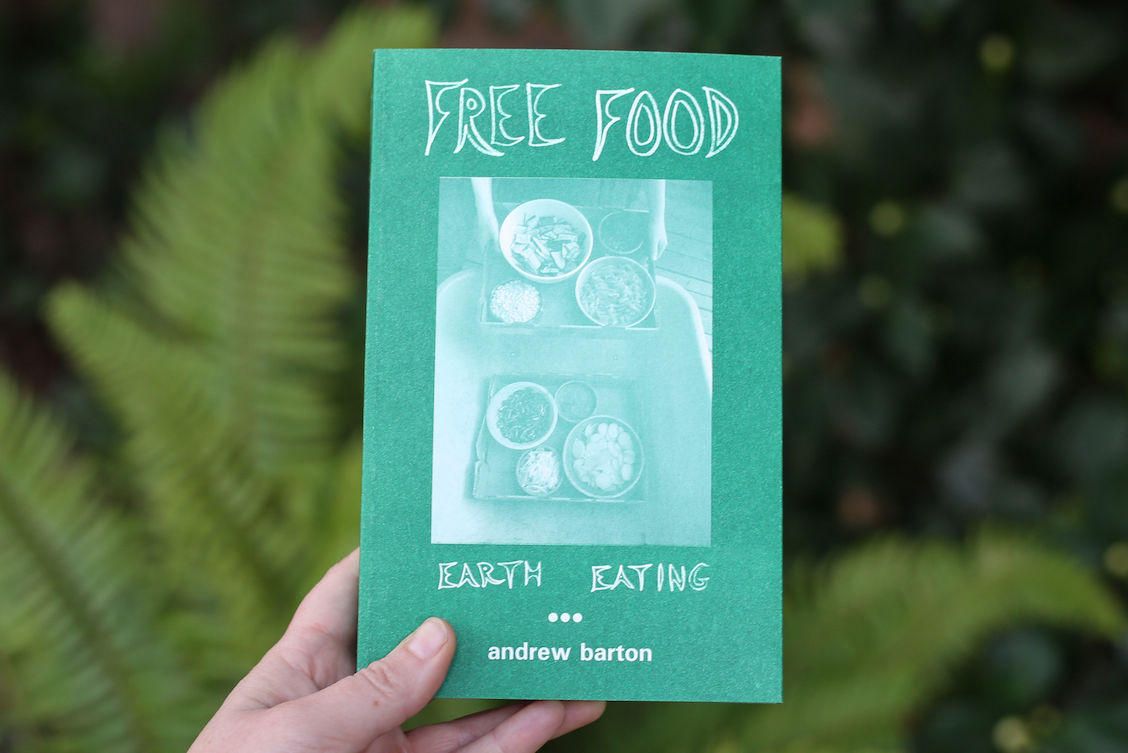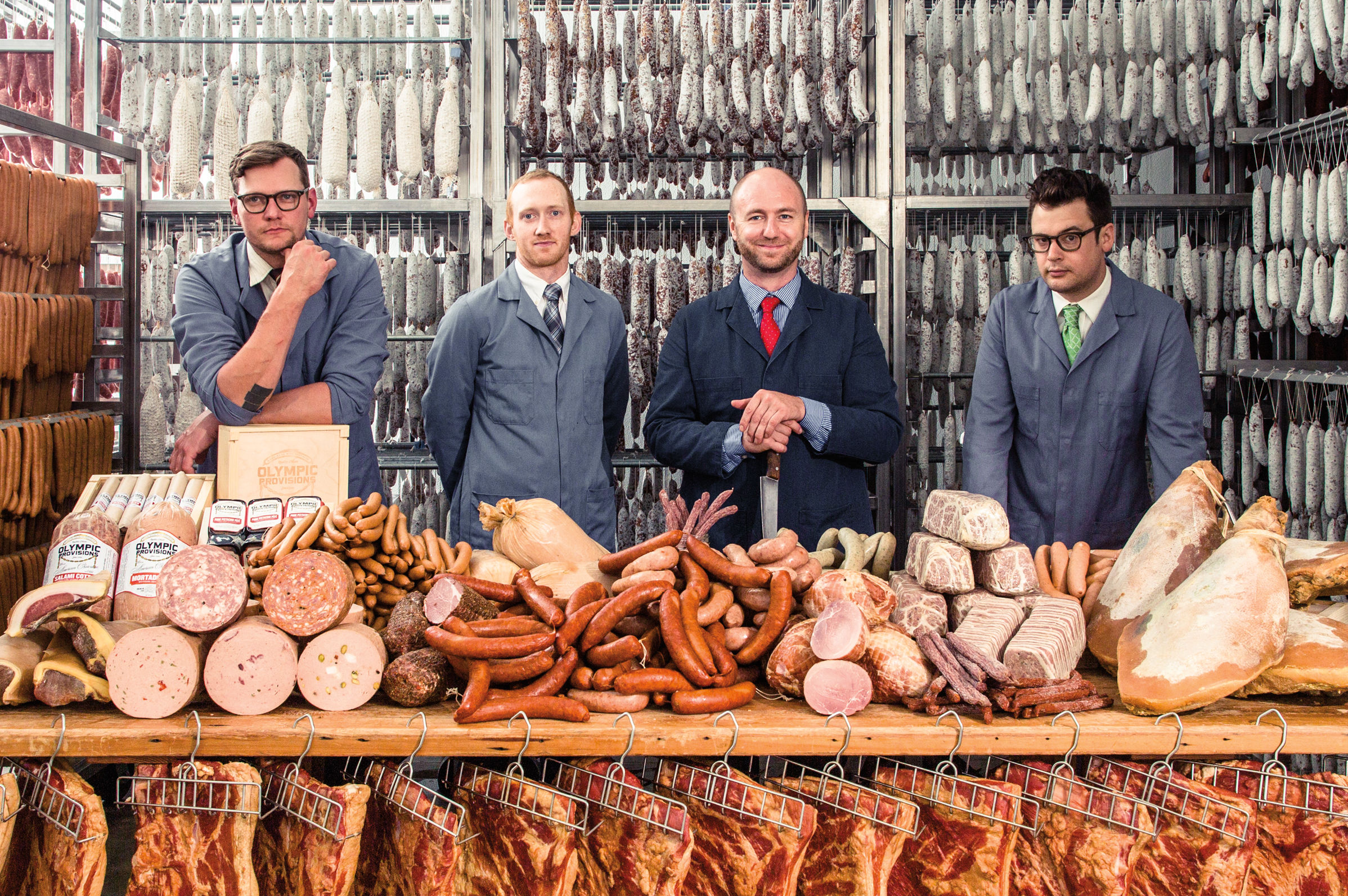
A First Look at the New Olympia Provisions Cookbook
Olympia Provisions salami—slender, shriveled truncheons coated in white penicillium and redolent of garlic, ripe age, and complex spice—may be Portland’s greatest artisan export. After just six years in business, the company distributes 700,000 pounds of cured pork product to 40 states every year, runs two of the city’s most popular restaurants, and regularly earns accolades from the likes of Bon Appétit, Oprah, and the New Yorker. And in October, with the release of Olympia Provisions (Ten Speed Press), this phenomenon becomes globalist sausage-maker to a nation suddenly (and improbably) hungry for cumin-infused loukanika and pork-liver mousse.
The cookbook is as much about the company’s founder, Elias Cairo, as it is about the realm of cured pork he’s created. A compact, blue-eyed charmer with a scruffy smile, Cairo is a rare crossbreed of western adventurer and Old World outdoorsman—he hunts pheasant and fishes for trout in his spare time. The second-generation Greek-American spent much of his youth in northern Utah’s Mormon heartland, trained in the tucked-away Swiss mountain village of Wildhaus, and leapfrogged the ranks at SE Hawthorne’s storied Castagna to become executive chef in 2006. Cairo’s dream of opening Oregon’s first USDA-approved meat plant inside a restaurant finally coalesced in 2009, when he assembled a crew of cofounders including his sister Michelle Cairo, Clyde Common’s Nate Tilden, Marty Schwartz, and Tyler Gaston, a US Navy officer turned country singer.

The 170-year-old Aescher Hotel in the Swiss Alps: an early stop on Cairo’s Wildhaus comeback tour, and home to some of the world’s best charcuterie
Image: Eric Wolfinger
In Olympia Provisions, Cairo teams with coauthor Meredith Erickson (The Art of Living According to Joe Beef, Le Pigeon: Cooking at the Dirty Bird) to chronicle his own misadventures in jocular, self-effacing detail. The pair return to Wildhaus to eat their way through his origin story. They vividly catalog the greatest hits from OP’s restaurant menus. And, most important, they get deep into charcuterie.
Cairo is quick to admit that charcuterie is one of the most difficult things to make in a home kitchen. “‘Quick charcuterie’ is a contradiction in terms,” he says. “It doesn’t exist. Like traveling by train, making great charcuterie takes patience—and like Amtrak, it can be a little smelly.”
For those up for the adventure, Olympia Provisions is one of the most impressive cookbooks in recent years, in a class with Yotam Ottolenghi’s Plenty and David Chang’s Momofuku. Thorough in its processes, comprehensive in its grasp of the subject, and beguiling as a piece of travel literature, it brings strange worlds to life, both in words and photographs. And critically, it’s one of the most digestible charcuterie books written for the English language—a tall order for a craft that’s more science than cooking.
HEAR MORE FROM OLYMPIA PROVISIONS CO-FOUNDER ELI CAIRO:
Capicola
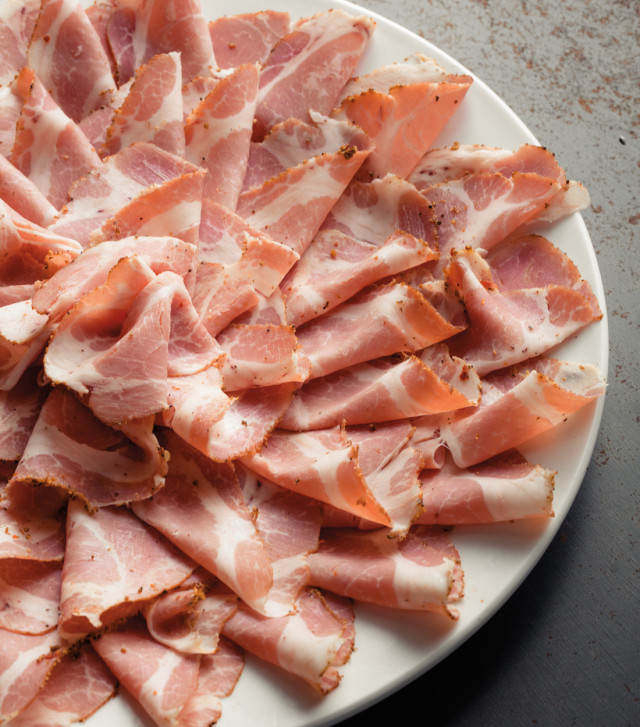
Image: Eric Wolfinger
(Makes one 2½-pound capicola)
For your first foray into the world of charcuterie, go with capicola. It requires no knife work, no meat grinding, and no sausage stuffing. Cairo explains: “Capicola to Italians, capocollo to Americans, capicolla to Canadians, ‘gabagoul’ to Tony Soprano—whatever you call it, capicola is made from the neck of the pig, coppa, and prized for its perfect [fat] ratio, making the meat moist and tender. One can’t make a proper Italian sub (or, I’d say, any proper lunchbox sandwich) without capicola.”
3 lbs pork coppa*
2 tbsp plus 1 tsp fine sea salt
2 tbsp sugar
2 tsp crushed red pepper flakes
1 tsp curing salt #1 (available at the Meadow)
2 tsp black peppercorns
1⁄2 tsp fennel seeds
1⁄2 tsp aniseed
Size 16 ham net**
1. To make the cure, mix together sea salt, sugar, 1 tsp of the red pepper, and curing salt. Place pork in a large bowl and massage with the cure, working it into the cracks. Wrap tightly in plastic wrap (or put into a big zip-top bag), place on a dish, and refrigerate for 5 days. Flip it over and refrigerate for another 5 days.
2. After 10 days of curing, remove meat from refrigerator and unwrap it. Rinse under cold water until salt and spice are removed. Prepare rub by coarsely grinding the remaining 1 tsp of red pepper flakes, peppercorns, fennel seeds, and aniseed using a mortar and pestle. Pour rub into a large bowl and add meat, turning to coat it well. Preheat oven to 250 degrees. Place a roasting pan with 2 inches of water in the middle rack of the oven to create humidity. Put meat into a ham net and tie closed on both ends. Place meat in a second roasting pan and cook for 1 hour on the top rack. Turn meat over and cook for 1 hour longer, or until the internal temperature reaches 155 degrees.
3. Remove from oven, transfer to a plate, and refrigerate, uncovered, for 3 to 4 hours, or until the internal temp is below 39 degrees. Wrapped tightly in plastic wrap, unsliced capicola will keep for 3 weeks in the refrigerator.
*Ask a good butcher, like Laurelhurst Market or Chop, for the coppa, which will need to be custom cut from a whole shoulder.
**A ham net is a bag made of cotton netting used for smoking meats. Buy one online at sausagemaker.com.
Baked Shrimp with Chèvre
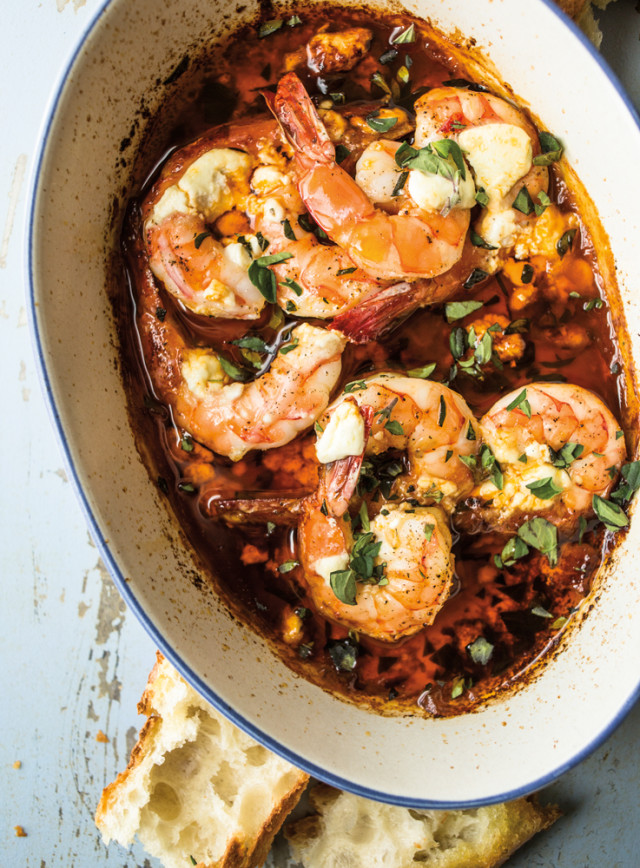
Image: Eric Wolfinger
(Serves 2)
This fiery dish perfectly encapsulates the menu at the original OP restaurant, in the shadow of the Morrison Bridge: chef Alex Yoder is captivated by all things Mediterranean, with seafood on a pedestal. He added this dish to the lineup early on as a play on the classic Greek garides saganaki. Instead of baking shrimp with tomato and feta, as per tradition, Yoder poaches the plump crustaceans in smoky chile oil, as creamy dollops of chèvre slowly slide into the red-stained bath.
½ cup extra-virgin olive oil
½ tsp sweet paprika
¼ tsp cayenne
⅛ tsp smoked paprika
8 jumbo shrimp, deveined
Kosher salt and ground black pepper
6 oz chèvre
2 tbsp coarsely chopped fresh oregano
Lemon wedges and warm crusty bread, for serving
1. In a small bowl or a glass jar, stir together the olive oil, sweet paprika, cayenne, and smoked paprika. Cover and set in a warm place for at least 12 hours.
2. Preheat the oven to 400 degrees. Season the shrimp with kosher salt and black pepper. Pour the chile oil into a baking dish large enough to fit the shrimp in a single layer. Add the shrimp to the dish, laying them flat, and crumble the chèvre over the top.
3. Bake until the shrimp are fully cooked and the cheese is beginning to bubble and brown, about 20 minutes. Sprinkle the oregano evenly over the shrimp and serve with lemon wedges and bread for dipping.
Pear Tart
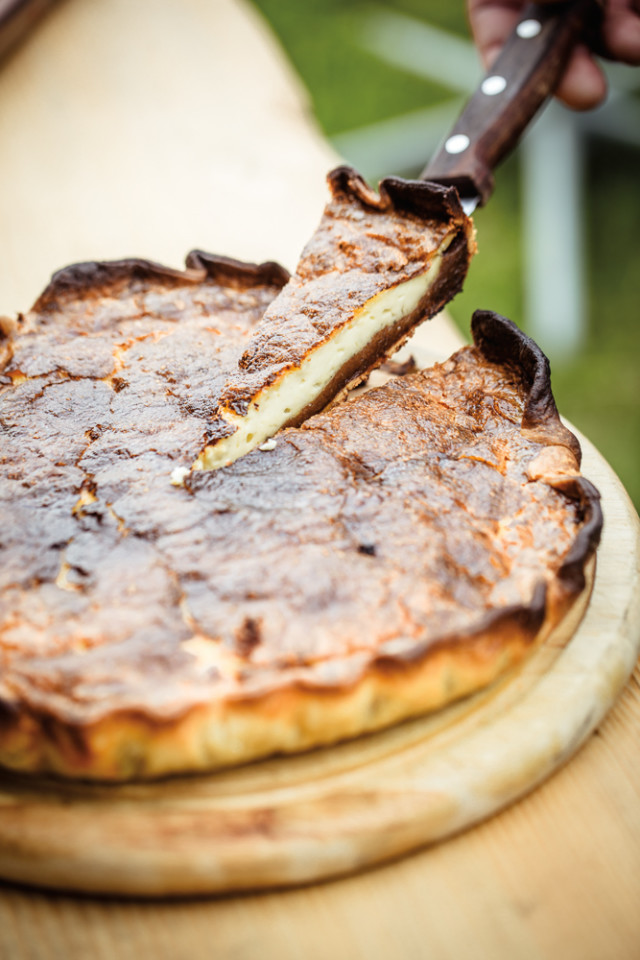
Image: Eric Wolfinger
(Makes one tart)
In 1991, Cairo moved to Wildhaus, a small village in northeastern Switzerland, to apprentice at a remote restaurant called Stump’s Alpenrose under master chef Annegrit Schlumpf. During that time, Cairo would eat the pear tart (schlorzifladen) every day for breakfast. “Part fig newton, part custard, this tart had immediate impact,” remembers Cairo. “Every little valley has their own pastry. The Toggenburg’s signature tart comes from their thick pear orchards.”
Pie dough*
Pear paste**
2¼ cups heavy cream
2 eggs
1 tbsp and 1 tsp sugar
1 vanilla bean, split and scraped
1 tsp kosher salt
1 pinch nutmeg
½ tsp black pepper
1. Preheat oven to 350 degrees. Butter a 9-inch pie mold. On a lightly floured surface, roll out the dough into a 12-inch-wide, ¼-inch-thick circle. Carefully drape dough over the buttered mold and crimp the edges over the rim. Blind-bake crust by covering dough with tinfoil, adding a weight (like dried beans), and baking for 25 minutes.
2. In a large bowl, beat eggs together and whisk in cream, vanilla, sugar, salt, nutmeg, and pepper until just combined. Using the back of a spoon, spread pear paste evenly inside the pie shell. Gently pour the cream-egg mixture over the top. Place in the oven and increase heat to 400 degrees, baking for 45 minutes to an hour, or until top is golden brown. (Custard will still be very loose.) Let cool at room temperature, then refrigerate for at least 45 minutes. Serve at room temperature or slightly chilled.
*PIE DOUGH
2½ cups all-purpose flour
½ tsp kosher salt
1 tsp sugar
2 sticks cold, unsalted butter, cut into small cubes
¼– ½ cup cold water
Add flour, salt, and sugar to a food processor and pulse to combine. Add butter and pulse until the butter is in pea-size chunks. Add water and pulse a few seconds longer, or until the dough comes together. Shape dough into a flattened disk, wrap in plastic, and refrigerate for an hour or overnight.
**PEAR PASTE
2½ cups dehydrated pears
1 oz Kirsch (or other fruit brandy)
2 tbsp sugar
¼ tsp ground cloves
1 tsp ground cinnamon
1 pinch ground black pepper
1 pinch ground star anise
Bring 3 cups water to a boil, add pears, cover, and simmer for 20 minutes. Remove pears and blend with the remaining ingredients in a food processor to reach an applesauce-like consistency.


